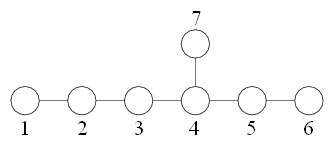E7 (mathematics)
In mathematics, E7 is the name of several Lie groups and also their Lie algebras . It is one of the five exceptional compact simple Lie groups as well as one of the simply laced groups. E7 has rank 7 and dimension 133. The fundamental group of the compact form is the cyclic group Z2, and its outer automorphism group is the trivial group. The dimension of its fundamental representation is 56.
The compact real form of E7 is the isometry group of a 64-dimensional Riemannian manifold known informally as the 'quateroctonionic projective plane' because it can be built using an algebra that is the tensor product of the quaternions and the octonions. This can be seen systematically using a construction known as the 'magic square', due to Hans Freudenthal and Jacques Tits. There are three other real forms, and one complex form.
Algebra
Dynkin diagram

Root system
Even though the roots span a 7-dimensional space, it is more symmetric and convenient to represent them as vectors lying in a 7-dimensional subspace of an 8-dimensional vector space.
The roots are all the 8×7 permutations of (1,−1,0,0,0,0,0,0)
and all the permutations of (1/2,1/2,1/2,1/2,−1/2,−1/2,−1/2,−1/2)
Note that the 7-dimensional subspace is the subspace where the sum of all the eight coordinates is zero. There are 126 roots.
The simple roots are
(0,-1,1,0,0,0,0,0)
(0,0,-1,1,0,0,0,0)
(0,0,0,-1,1,0,0,0)
(0,0,0,0,-1,1,0,0)
(0,0,0,0,0,-1,1,0)
(0,0,0,0,0,0,-1,1)
(1/2,1/2,1/2,1/2,−1/2,−1/2,−1/2,−1/2)
We have ordered them so that their corresponding nodes in the dynkin diagram are ordered from left to right (in the diagram depicted above) with the side node last.
An alternative description
An alternative (7-dimensional) description of the root system, which is useful in considering as a subgroup of , is the following:
All permutations of
- preserving the zero at the last entry,
all of the following roots with an even number of +1/2
and the two following roots
- .
Thus the generators comprise of a 66-dimensional subalgebra as well as 65 generators that transform as two self-conjugate Weyl spinors of of opposite chirality and their chirality generator, and two other generators of chiralities
The simple roots in this description are
(-1/2,-1/2,-1/2,-1/2,-1/2,-1/2,)
(1,1,0,0,0,0,0)
(0,-1,1,0,0,0,0)
(0,0,-1,1,0,0,0)
(0,0,0,-1,1,0,0)
(0,0,0,0,-1,1,0)
(-1,1,0,0,0,0,0)
Again we have ordered them so that their corresponding nodes in the dynkin diagram are ordered from left to right (in the diagram depicted above) with the side node last.
Cartan matrix
Important subalgebrass and representations
E7 has an subalgebra, as is evident by noting that the in 8-dimensional description of the root system, the first group of roots are identical to the roots of (with the same Cartan subalgebra as in the E7).
In addition to the 133-dimensional adjoint representation, there is a 56-dimensional "vector" representation.
Importance in physics
N=8 supergravity in four dimensions, which is a dimensional reduction from 11 dimensional supergravity, admit an E7 bosonic global symmetry and an bosonic local symmetry. The fermions are in representations of , the gauge fields are in a representation of E7, and the scalars are in a representation of both (Gravitons are singlets with respect to both). Physical states are in representations of the coset .
In string theory, E7 appears as a part of the gauge group of one the (unstable and non-supersymmetric) versions of the heterotic string.
References
- John Baez, The Octonions, Section 4.5: E7, Bull. Amer. Math. Soc. 39 (2002), 145-205. Online HTML version at
http://math.ucr.edu/home/baez/octonions/node18.html.
- E. Cremmer and B. Julia, The N=8 Supergravity Theory. 1. The Lagrangian, Phys.Lett.B80:48,1978. Online scanned version at
http://ccdb4fs.kek.jp/cgi-bin/img_index?7810033.















